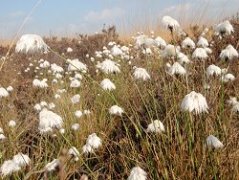http://www.lancswt.org.uk/places-to-see/astley-moss
So firstly, what is a lowland raised bog, a lowland raised bog occurs on impermeable ground such as sand or clay. Sphagnum moss grown upon water filled holes within this ground, eventually the moss will condense and grown until a dome forms as the peat accumulates .
History of our bogs
Lowland raised bogs used to cover a vast area within Lancashire. A railway was built, running between Liverpool and Manchester on top of these bogs and due to this new access to the bogs the peat was farmed and used and horse bedding. Once this was done the horse bedding, was then spread back over the bogs; however this then included horse manure, which made it great for agriculture, but made it impossible for peat bogs to form for around 1,000 years.
Due to this, the peat bog declined and 60% was lost in 50 years, after which another 50% of the remaining bog was lost in the next 50 years. With the current status now at only 12% of the original peat bog remaining.
Why is it so important ?
Peat bogs create wild space within our environment and with these bogs being so close to urbanised areas, they create a great opportunity for people to encounter truly wild space.
Peat bogs are also great at absorbing carbon, with around 20% more carbon capacity than our forests. This is massively important in are fight against climate change as bogs can hold as much carbon and the UK procures in 35 years.
These also hold great secrets about Britain’s history unearthing trees over 10,000 years old under these bogs. As well as natural secrets, these bogs may also hold the key to some unanswered questions about humans past. ‘Bog bodies’ have been found here that could age back between 4-5,000 years. Some of these bodies have also been holding fire starting kits, which could tell us huge amounts about our history

http://archive.archaeology.org/1005/bogbodies/
The Manchester mosses
There are three mosses currently owned by the Lancashire wildlife trust in the Manchester area.
1. Astley moss- this area was bought in the early 1980’s and has many threats such as water loss and nutrient enrichment. Much work has been done on this area, including felling trees and increasing the amount of sphagnum moss on the site. The restoration of this bog has been successful so far, however there is still a long way to go to restore back to its original state.
2. Cadishead moss- Releveling was done here to ensure, the water level was high and constant throughout, so optimal conditions could be achieved for plant growth. This involved taking ground from higher levels and transferring it into lower levels so that a constant altitude was achieved throughout.
3. Little woolden moss- this area was bought very recently in August of 2012. This buy was urgent as it was in the process of being turned into agricultural land.
Managements
The management and restoration of these mosses includes:
-scrub clearances
-blocking drainage ditches and raising the water table
– removing invasive species, such as balsam
-translocating sphagnum from sights of high density to areas of low density
-propagating moss land plants in nurseries, so that healthy populations can be maintained
Future
With these bogs creating habitats for many species, including many raptors, endangered butterflies, brown hares, water vowels and even cranes, it is of the up-most important that these areas are protected. The Lancashire wildlife trust organises talk, events and walks to help raise both awareness and money so that hopefully in the future these bogs can be restored to their original state.

Whilst conducting research on the issue of freshwater pollution, I too was surprised by the important role of wetland areas such as bogs, have in ecosystems. I was only expecting to uncover studies regarding the effects of pollution on lakes and rivers. Instead I found myself presented with a majority of articles mainly concerning the effects of pollutants on wetlands.
Reading this post gave me a refreshing perspective on habitat conservation. Not only are bogs supportive of biodiversity, they also help to mitigate the effects of climate change. The notion of bogs containing artifacts of an anthropological nature, such as the ones described, had not previously occurred to me. This blog post helped me to realise that bogs and wetlands in general, can hold many ecological benefits and that some of their associated benefits can be integral to the ancestral heritage of an area.
[…] https://bsue22.wordpress.com/2014/04/04/restoring-britains-lowland-raised-bogs-why-is-it-so-important… […]
[…] https://bsue22.wordpress.com/2014/04/04/restoring-britains-lowland-raised-bogs-why-is-it-so-important… […]
[…] https://bsue22.wordpress.com/2014/04/04/restoring-britains-lowland-raised-bogs-why-is-it-so-important… […]